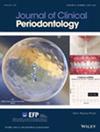牙周病患者生活方式与口腔/粪便微生物谱的相互作用:一项横断面研究
IF 6.8
1区 医学
Q1 DENTISTRY, ORAL SURGERY & MEDICINE
引用次数: 0
摘要
目的了解牙周健康(PH)和疾病患者的牙周和粪便微生物群特征,并评估与牙周、社会人口统计学、人体测量学、营养和生活方式因素的关系。材料与方法对PH、牙龈炎(GG)和牙周炎(PE)患者(n = 24/组)的牙根生物膜和粪便样本进行16S rRNA测序。收集了人体测量数据和人口统计、生活方式、饮食和肠道习惯问卷。对资料进行统计学分析(p < 0.05)。结果与ph组相比,gg组和PE组的年龄、BMI、腰/腹围和反式脂肪摄入量更高,硒和维生素E摄入量更低。PE组的臀围更高,收入、受教育程度和铁、维生素A和B9的摄入量更低。PE微生物组(口腔和粪便)组成不同,口腔特有菌种数量最多。与ph相比,PE和GG的粪便丰富度较低。特定的微生物分类群与牙周状态和宿主因素相关。结论牙周和粪便微生物组因牙周状况而异。判别分析将77%的个体根据牙周状况进行分类,PE的关键标志包括年龄较大、饮食质量差和明显的口腔和粪便微生物特征。这些发现强调了临床、饮食和微生物因素在牙周病分析中的作用。本文章由计算机程序翻译,如有差异,请以英文原文为准。
The Interplay Between Lifestyle and Oral/Faecal Microbial Profiles Among Periodontal Disease Patients: A Cross-Sectional Study.
AIM
To characterise periodontal and faecal microbiomes of individuals with periodontal health (PH) and diseases, and evaluate associations with periodontal, sociodemographic, anthropometric, nutritional and lifestyle factors.
MATERIALS AND METHODS
Dental biofilm and faecal samples from individuals (n = 24/group) with PH, gingivitis (GG) and periodontitis (PE) were sequenced (16S rRNA). Anthropometric data and questionnaires on demographics, lifestyle, diet and intestinal habits were collected. Data were statistically analysed (p < 0.05).
RESULTS
GG and PE groups showed higher age, BMI, waist/abdominal circumferences and trans-fat intake and lower selenium and vitamin E intake compared to PH. Individuals with PE had higher hip circumference and lower income, education and intake of iron as well as vitamins A and B9. PE microbiomes (oral and faecal) showed distinct compositions, with the highest number of unique oral species. Faecal richness was lower in PE and GG compared to PH. Specific microbial taxa correlated with periodontal status and host factors.
CONCLUSION
Periodontal and faecal microbiomes vary across periodontal conditions. Discriminant analysis classified 77% of individuals by periodontal status, with key markers for PE including older age, poor dietary quality and distinct microbial oral and faecal signatures. These findings highlight the role of clinical, dietary and microbial factors in periodontal disease profiling.
求助全文
通过发布文献求助,成功后即可免费获取论文全文。
去求助
来源期刊

Journal of Clinical Periodontology
医学-牙科与口腔外科
CiteScore
13.30
自引率
10.40%
发文量
175
审稿时长
3-8 weeks
期刊介绍:
Journal of Clinical Periodontology was founded by the British, Dutch, French, German, Scandinavian, and Swiss Societies of Periodontology.
The aim of the Journal of Clinical Periodontology is to provide the platform for exchange of scientific and clinical progress in the field of Periodontology and allied disciplines, and to do so at the highest possible level. The Journal also aims to facilitate the application of new scientific knowledge to the daily practice of the concerned disciplines and addresses both practicing clinicians and academics. The Journal is the official publication of the European Federation of Periodontology but wishes to retain its international scope.
The Journal publishes original contributions of high scientific merit in the fields of periodontology and implant dentistry. Its scope encompasses the physiology and pathology of the periodontium, the tissue integration of dental implants, the biology and the modulation of periodontal and alveolar bone healing and regeneration, diagnosis, epidemiology, prevention and therapy of periodontal disease, the clinical aspects of tooth replacement with dental implants, and the comprehensive rehabilitation of the periodontal patient. Review articles by experts on new developments in basic and applied periodontal science and associated dental disciplines, advances in periodontal or implant techniques and procedures, and case reports which illustrate important new information are also welcome.
 求助内容:
求助内容: 应助结果提醒方式:
应助结果提醒方式:


